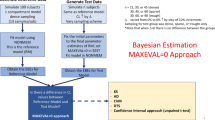Abstract
The purpose of this study was to evaluate the effects of population size, number of samples per individual, and level of interindividual variability (IIV) on the accuracy and precision of pharmacodynamic (PD) parameter estimates. Response data were simulated from concentration input data for an inhibitory sigmoid drug efficacy (Emax) model using Nonlinear Mixed Effect Modeling, version 5 (NONMEM). Seven designs were investigated using different concentration sampling windows ranging from 0 to 3 EC50 (EC50 is the drug concentration at 50% of the Emax) units. The response data were used to estimate the PD and variability parameters in NONMEM. The accuracy and precision of parameter estimates after 100 replications were assessed using the mean and SD of percent prediction error, respectively. Four samples per individual were sufficient to provide accurate and precise estimate of almost all of the PD and variability parameters, with 100 individuals and IIV of 30%. Reduction of sample size resulted in imprecise estimates of the variability parameters; however, the PD parameter estimates were still precise. At 45% IIV, designs with 5 samples per individual behaved better than those designs with 4 samples per individual. For a moderately variable drug with a high Hill coefficient, sampling from the 0.1 to 1,1 to 2,2 to 2.5, and 2.5 to 3 EC50 window is sufficient to estimate the parameters reliably in a PD study.
Similar content being viewed by others
References
Braat MC, Jonkers RE, Bel EH, Van Boxtel CJ. Quantification of theophylline-induced eosinopenia and hypokalaemia in healthy volunteers.Clin Pharmacokinet. 1992;22:231–237.
White DB, Walawander CA, Tung Y, Grasela TH. An evaluation of point and interval estimates, in population pharmacokinetics using NONMEM analysis.J Pharmacokinet Biopharm. 1991;19:87–112.
Beal SL, Sheiner LB.NONMEM User's Guide Parts I–VIII. San Francisco: University of California, San Francisco, 1998.
Jonsson EN, Wade JR, Karlsson MO. Comparison of some practical sampling strategies for population pharmacokinetic studies.J Pharmacokinet Biopharm. 1996;24:245–263.
Sun H, Ette EI, Ludden TM. On the recording of sample times and parameter estimation from repeated measures pharmacokinetic data.J Pharmacokinet Biopharm 1996;24:637–650.
Hashimoto Y, Sheiner LB. Designs for population pharmacodynamics: value of pharmacokinetic data and population analysis.J Pharmacokinet Biopharm. 1991;19:333–353.
Girgis S, Rosenbaum S. Optimum design for pharmacodynamics.Clin Pharmacol Ther. 2000;67:163.
Sheiner LB, Beal SL. Some suggestions for measuring predictive performance.J Pharmacokinet Biopharm. 1981;9:503–512.
al-Banna MK, Kelman AW, Whiting B. Experimental design and efficient parameter estimation in population pharmacokinetics.J Pharmacokinet Biopharm. 1990;18:347–360.
Ette EI, Howie CA, Kelman AW, Whiting, B. Experimental design and efficient parameter estimation in preclinical pharmacokinetic studies.Pharm Res. 1995;12:729–737.
Author information
Authors and Affiliations
Corresponding author
Additional information
Published: October 5, 2005
Rights and permissions
About this article
Cite this article
Girgis, S., Pai, S.M., Girgis, I.G. et al. Pharmacodynamic parameter estimation: Population size versus number of samples. AAPS J 7, 46 (2005). https://doi.org/10.1208/aapsj070246
Received:
Accepted:
DOI: https://doi.org/10.1208/aapsj070246




